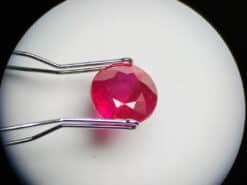Glass filled ruby

Filling the fractures or fissures inside the ruby with lead glass or a similar material dramatically improves the transparency of the stone, making previously unsuitable rubies fit for applications in jewelry. Glass filled ruby identification is quite simple and its value is more affordable than an untreated ruby.
Buy natural glass filled ruby in our shop
Lead glass filled ruby
- The rough stones are pre-polished to eradicate all surface impurities that may affect the process
- The rough stone is cleaned with hydrogen fluoride
- The first heating process during which no fillers are added. The heating process eradicates impurities inside the fractures. Although this can be done at temperatures up to 1400 °C (2500 °F) it most likely occurs at a temperature of around 900 °C (1600 °F) since the rutile silk is still intact.
- The second heating process in an electrical oven with different chemical additives. Different solutions and mixes have shown to be successful, however mostly lead-containing glass-powder is used at present. The ruby is dipped into oils, then covered with powder, embedded on a tile and placed in the oven where it is heated at around 900 °C (1600 °F) for one hour in an oxidizing atmosphere. The orange colored powder transforms upon heating into a transparent to yellow-colored paste, which fills all fractures. After cooling the color of the paste is fully transparent and dramatically improves the overall transparency of the ruby.
Color
If a color needs to be added, the glass powder can be “enhanced” with copper or other metal oxides as well as elements such as sodium, calcium, potassium etc.
The second heating process can be repeated three to four times, even applying different mixtures. When jewelry containing rubies is heated for repairs. It should not be coated with boracic acid or any other substance, as this can etch the surface. It does not have to be protected like a diamond.
Glass filled ruby identification
The treatment can be identified by noting bubbles in cavities and fractures using a 10× loupe.
FAQ
How can I tell if a ruby is glass filled?
The most notorious visual characteristic of a composite ruby is the internal gas bubbles. These can be single spheres or clouds of bubbles, flattened or rounded, and they are present in virtually all fissure filled rubies. On most occasions, they are visible even to an unaided eye.
Is lead filled ruby natural?
Yes, It is a treated stone. Created using heat and an element to bring the deep red color like a untreated ruby, The gemstone is treated to fill the fractures that are there in the stone. These gems looks like untreated stones, but they don’t match the strength and resilience that the genuine stones have.
is lead glass ruby worthless?
Glass filled ruby value is much cheaper than an untreated ruby. The effectiveness of the treatment is amazing, in that it transforms corundum that is opaque and nearly worthless into material that is transparent enough for use in jewelry. Indeed, the stones can seem very appealing to an untutored buyer. It can be ten to thousand times cheaper than a same looking untreated stone.
What is lead glass filled ruby value?
Not treated gems have higher value and cost then treated ones, even if also the latter can boast excellent qualities and splendor. Taking into account the case of lead glass filled rubies, we can state that a reliable seller has the responsibility to describe gems with their real proprieties, despite of their beauty.
Natural glass filled ruby for sale in our shop
We make custom jewelry with fissure filled ruby as ring, earrings, bracelet, necklace or pendant… Please contact us for a quote.
















